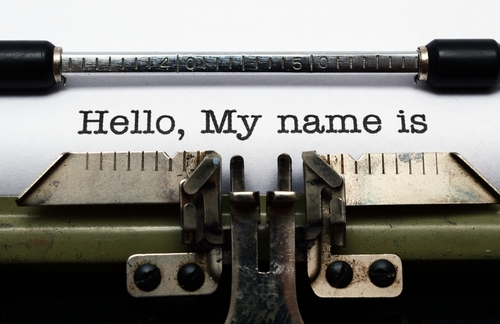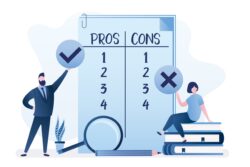If you changed your last name to your spouse’s surname when you got married, is it best to change your name back to your original family/birth name, or keep your married name? If you feel overwhelmed at the prospect of changing your name, you’re not alone – a name change can have a significant psychological and emotional impact.
Changing your name is stressful, personal, and can be a very emotional process. Your face and your name are the two things most closely tied to your identity. In fact, cults often require members to change their name upon joining. Forcing someone to give up their old name (and identity) exercises power over that person, removing new members from their past lives and personal connections. Taking a new name is also how new members show their commitment to the group.
While changing your name for marriage or divorce is (hopefully) more pleasant than giving up your name for a cult, a name change for any reason can be stressful, including divorce.
There are pros and cons of keeping your married name vs. changing it back to your original/family name. As with any major decision, what’s right for you depends upon your unique circumstances. In an unscientific poll, here’s what people generally cited as the deciding factors in their name change decision:
- Kids: Many women with kids share that they prefer to have the same name as their children, so they keep their married name.
- Work & Social Factors: How well are you known by your married name? (How long have you been married? And have you established a professional reputation, friends, identity, etc. with your married name?)
- Time & Hassle: Changing your name requires chasing down a lot of documents, and getting all accounts and possessions changed over, if you decide to change back from your married name.
Options to avoid the hassles and emotional toll of a name change
There are a few options for avoiding the emotional toll of having to choose between keeping your ex-spouse’s name or going back to your former pre-marital name.
- Change to a completely different name other than married or maiden/original surnames. If you can’t decide between keeping your spouse’s name or returning to your original/family surname, you could change to another name entirely. Some women choose another family name, such as their mother’s maiden name, if they don’t wish to return to using their own original/family name. Some select a name outside of the family altogether.
- Hyphenated names – this enables you to keep your married name as a tie to your children, for example (a reason many women cite for keeping their married names), while also maintaining an identity separate from your ex-spouse.
- No name change at all – This option is one you would have had to have chosen upon marriage, but an increasing number of women today are choosing NOT to take their husband’s surname when marrying. By keeping your pre-marital name, you never have to deal with the name change when you get married, nor upon divorce, if applicable.
A divorce decree is the easiest way to change your name
If you do decide to change your name back to your previous name, the easiest way to do so is at the time of your divorce. The name change can simply be written into the divorce decree, and once the divorce is final, your name will legally revert to your maiden name as requested. Then it’s up to you to get all your other accounts and files changed over to your current name, which will take time and effort on your part. Below is a list of the various items you’ll need to get updated with your new (old) name:
- Driver’s license
- Social security card
- Bank accounts
- Credit cards and credit lines
- Retirement accounts
- Insurance policies – medical, homeowners, auto, life, etc.
- Mortgage
- Car note
- Passport
- Voter registration
- Employment file, if applicable
- Any other entities such as business memberships, business ownership, financial institutions, wills, any other legal documents, etc.
The process varies by state, and you may need a lawyer
If you are already divorced and you didn’t opt for the name change to be part of your divorce decree, then you’ll need to go through a legal process to change your name. The name change process varies by state, but in most cases, you should be able to change your name without any professional legal assistance. It will probably cost about $150-300 in court fees or administrative fees.
That said, there are legal implications to a name change, so if you’re not sure, you may want to consult with an attorney, perhaps the one who helped you with your divorce. If you don’t wish to pay an attorney, you can start by searching online about the name change process for your state. Most likely, the name change process information will be provided by your local county or municipal government websites, and you can complete the process without the assistance of an attorney.
The name change process typically involves filing a petition with the local court system, providing some documentation (birth certificate, divorce decree, etc.) and the reason for your name change. Then there may be a waiting period, and some states require a hearing to finalize the name change. Some states may allow you to complete the process almost entirely online.
Once the name change is finalized by the court system, you’ll receive documentation to show to financial institutions and government agencies to confirm your name change and get your new (old) name applied to all your accounts and files.
Women who changed their names share their stories
“I kept my married name for the kids, and because my business is my married name. I mainly kept it for my kids though. When they turn 18 and are out of school, I might change it.” – Julie S.
“I went back to my maiden name as soon as I could. It was written into my divorce decree so it was a court order, and I could legally change it post-divorce. I’m so glad to not have his name anymore. My son is about to turn 18, and he is going to legally change his name to my name as well. My daughter still has a few years to be able to legally change hers, but she already asks people to call her by my last name.” – Cindy A.
“I kept my married name. I have a son from that marriage, so I wanted the same name, plus I actually love the last name. My maiden name is Italian. No one can spell it or pronounce it. I’m still very proud of my heritage, I just don’t need the name on me all the time.” – Megan T.
“I went back to my maiden name as part of the decree. I wasn’t going to because I didn’t want a different last name than my daughter, but she (ever so wisely at 8 years old) said ‘a last name doesn’t change who you are to me.’ [It] broke my heart, but also made me beam with pride.” – Angela V.






